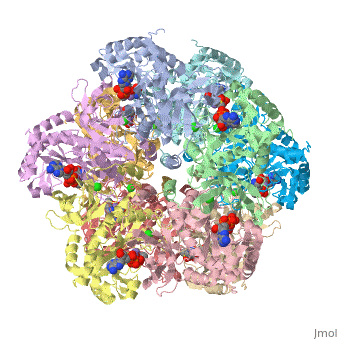User:Youngsen Jeng
From Proteopedia
Youngsen Jeng University of Maryland, Baltimore County Undergraduate Student Biological Science
Partnered with Youngdae Kim for a project. University of Maryland, Baltimore County Undergraduate Student Biological Science
Contents |
Project
| |||||||||
| 2qc8, resolution 2.60Å () | |||||||||
|---|---|---|---|---|---|---|---|---|---|
| Ligands: | , , , | ||||||||
| Gene: | GLUL, GLNS (Homo sapiens) | ||||||||
| Activity: | Glutamate--ammonia ligase, with EC number 6.3.1.2 | ||||||||
| Related: | 2ojw | ||||||||
| |||||||||
| |||||||||
| Resources: | FirstGlance, OCA, RCSB, PDBsum | ||||||||
| Coordinates: | save as pdb, mmCIF, xml | ||||||||
Glutamine Synthetase Exercise 1 by Youngsen&Youngdae
Exercise 1Dr Gluick's class
Glutamine Synthetase Exercise 2 by Youngsen&Youngdae
Exercise 2Dr. Gluick's class
Glutamine Synthetase Exercise 3 by Youngsen&Youngdae
Exercise 3Dr Gluick's class
Glutamine Synthetase Exercise 4 by Youngsen&Youngdae
Exercise 4Dr Gluick's class
Outline of the project
Glutamine Synthetase found in human enzyme, classed as Glutamine Synthetase II, is made up of ten identical subunits <Insert wiki here>. Glutamine Synthetase is a trimetallic enzyme containing two divalent cation sites (n1,n2) <Insert wiki here> and one monovalent cation site per subunit<Insert wiki here>. Structural stabilization of Glutamine Synthetase by divalent cations, especially by the n1 ion, has been ascribed to the attraction of the positive charges to the negative charges of glutamate and ATP and of their ligands. <Insert wiki here> The quaternary structure of Glutamine Synthetase is found to be stabilized by monovalent cations. (Ginsburg & Stadtman, 1973). The metal ions Mn2+ and Mg2+ are required for the activity and for the structural stability of Glutamine Synthetase. <Insert wiki here>. Interactions of the positively charged monovalent cation with the negatively charged substrate glutamate, Glu 212, Ser 53’, and Asp 50’ could strengthen the active conformation. <Insert wiki here> Because Ser 53’and Asp 50’reside at the subunit contact surface, the monovalent cation enhances the “side-to-side” intersubunit interaction. <Insert wiki here>


